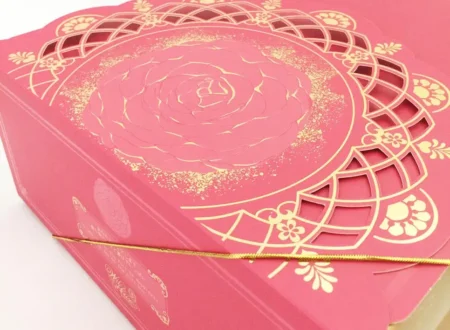One of the most frequently asked questions about packaging design is whether matte or gloss lamination is better. You may not know where to start regarding which surface treatment will benefit your packaging and your products when it comes to your brand. But worry not, as we’re here to help.
But when it comes to finding the best packaging solution for your business, there is no simple answer; it all depends on the occasion, purpose and style of the packaging pieces. In this article, we will explore and explain what gloss and matte lamination are, the differences and which option will work best for your brand and packaging needs.
Back to Basics: What is Lamination?
Let’s go back to basics and take an insightful look into what lamination is. Lamination is a bonding process in which a transparent plastic film is applied to a surface to add extra color protection and enhance the overall performance of the packaging. Lamination is typically applied by heat but can also be applied using adhesive.

Gloss and matte are the most popular lamination
options, but they aren’t the only ones.
Matte Lamination
To put it simply, matte lamination is a surface finishing that lacks shine. A matte surface reflects little to no light which is perfect when not in direct light.
A minimal reflected surface can easily adjust the intensity of the colors offered. As a result, matte lamination is a soft pallet to work with due to the mix of textures and tones. The result is an overall smooth finish with lower contrast on black tones. This gives it an overall classy and sophisticated look and feel.

Matte lamination is highly recommended for luxury
and elegant product packaging. This type of lamination adds a tactile effect
that oozes quality with a soft and velvety texture.
What is more, is that a matte finish decreases
scratches and scuffs. However, with that being said, it is less effective in
avoiding fingerprints, dust, and dirt. Finally, one of the greatest
advantages of matte lamination is the increase in quality perception while
still being an affordable choice.

Gloss Lamination
Entirely different to matte, gloss lamination produces a shiny, glass-like appearance that enhances the color and vibrancy of the surface of the packaging. This type of lamination adds a stronger image contrast and color depth, bringing any form of packaging to life.
Gloss lamination is visually attractive and durable, repels dust, dirt, and fingerprints, and is easy to clean, so is ideal if it’s going to be handled regularly.
However, scratches, indents, and imperfections are more visible on glossy surfaces; the glare from the lamination exposed to the light can overshadow the packaging or generate readability issues.
Now that we know each of the processes and the difference between matte and gloss, which one will you go for?
Which Lamination Option is Better?
The answer is down to the
packaging design and how that fits the brand and product’s needs. Only you will
know what is suitable for your business’s packaging, and making the right
choice can be difficult, but we’re here to help you along the way.
How to Choose the Right Lamination Finish
No one knows your product better than you, so to get the best results, evaluate the advantages of each finish, which will help you establish the one that is perfect for your brand. Think about the following:
· Is the location of the packaging going to be exposed to direct light? If so, use matte.
· Will the package be handled a lot? Use a gloss finish.
· Are you looking for a sophisticated look? Matte is the perfect finish.
· Want to save money? Gloss is usually cheaper than matte.
Other surface treatments available for your product packaging:
At HeTien, we also offer other types of packaging finishes which you can get in touch with us to discuss. But read on to find out more about choosing the right type of lamination for your packaging.
· Spot UV
· Debossing
Making the Right Choice
The choice between matte vs gloss lamination can be difficult, but it all depends on the printed piece and how you plan to use it. Both types of lamination provide a strong and transparent covering that makes the packaging, text and graphics completely visible but protected. However, as mentioned above, it is vital to keep in mind that matte absorbs light while gloss reflects it. This makes a big difference in the appearance of the printed piece and its impact on the end result. Let’s recap on when to choose matte vs gloss.
Choose matte laminate when:
· The printed piece will be situated underneath direct lighting (i.e., store signage or display lighting). The matte finish helps deflect any glare, making the printed packaging easier to read at any angle.
· The printed piece doesn’t get handled regularly. Matte laminates can easily be scratched or scuffed due to excessive use
· You want a modern, sophisticated look because matte always makes a great first impression
· The printed piece contains subdued colour tones.
Choose gloss laminate when:
· The printed piece of packaging is an item that gets handled a lot every day. Gloss provides a higher level of protection than matte and is easier to clean.
· You want the piece to make a strong visual impact. With gloss lamination, the colours seem to jump off the page.
· Avoiding glare is not a problem.
· Is price an issue? Gloss laminate costs less than matte so will save you some money.



